Street art photography captures the vibrant essence of urban culture while presenting unique challenges. This article explores essential techniques for composition and lighting, the importance of engaging with artists, and the cultural significance of street art in communities. It also addresses common obstacles photographers face, such as legal issues and safety concerns. Understanding these elements can enhance your appreciation and skill in this dynamic field.
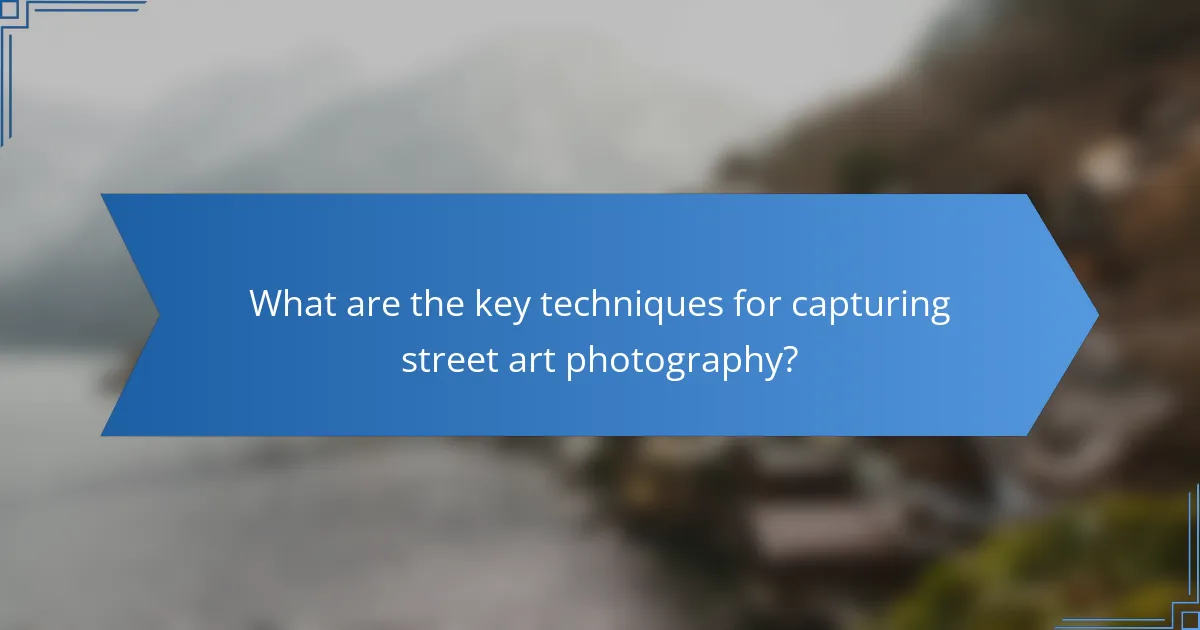
What are the key techniques for capturing street art photography?
To effectively capture street art photography, focus on composition, lighting, and context. Use a wide-angle lens to include surroundings, shoot during golden hour for optimal light, and consider the cultural significance of the art. Engaging with artists can provide deeper insights and unique perspectives.
How can lighting influence street art photography?
Lighting significantly enhances street art photography by shaping mood and highlighting details. Natural light, especially during golden hour, creates soft shadows and rich colors, emphasizing textures. Artificial lighting can add drama and contrast, influencing the viewer’s perception. Experimenting with different lighting conditions can lead to unique interpretations of urban art, revealing hidden aspects that may go unnoticed in harsh light. Understanding how light interacts with the artwork is crucial for capturing compelling images that resonate with audiences.
What camera settings are optimal for street art photography?
Optimal camera settings for street art photography include a fast shutter speed, wide aperture, and high ISO. Use a shutter speed of 1/250 seconds or faster to freeze motion. Set the aperture between f/2.8 and f/5.6 to achieve a shallow depth of field, highlighting the art. Adjust ISO between 400 and 1600 depending on lighting conditions, ensuring minimal noise while capturing vibrant details.
Which composition techniques enhance street art images?
Composition techniques that enhance street art images include framing, leading lines, and contrast. These techniques draw attention to the art and create dynamic visuals.
Framing focuses on surrounding the art with elements that highlight its significance. Leading lines guide the viewer’s eye toward the artwork, while contrast emphasizes colors and textures, making the piece stand out.
Utilizing these techniques can elevate street art photography, transforming ordinary shots into compelling narratives.
How can post-processing improve street art photographs?
Post-processing significantly enhances street art photographs by improving color accuracy, contrast, and overall composition. Techniques such as cropping, adjusting exposure, and applying filters can highlight the art’s details and textures. Additionally, digital editing can remove distractions, ensuring the focus remains on the artwork. These enhancements contribute to a more compelling visual narrative, allowing the cultural significance of the street art to resonate more powerfully with viewers.
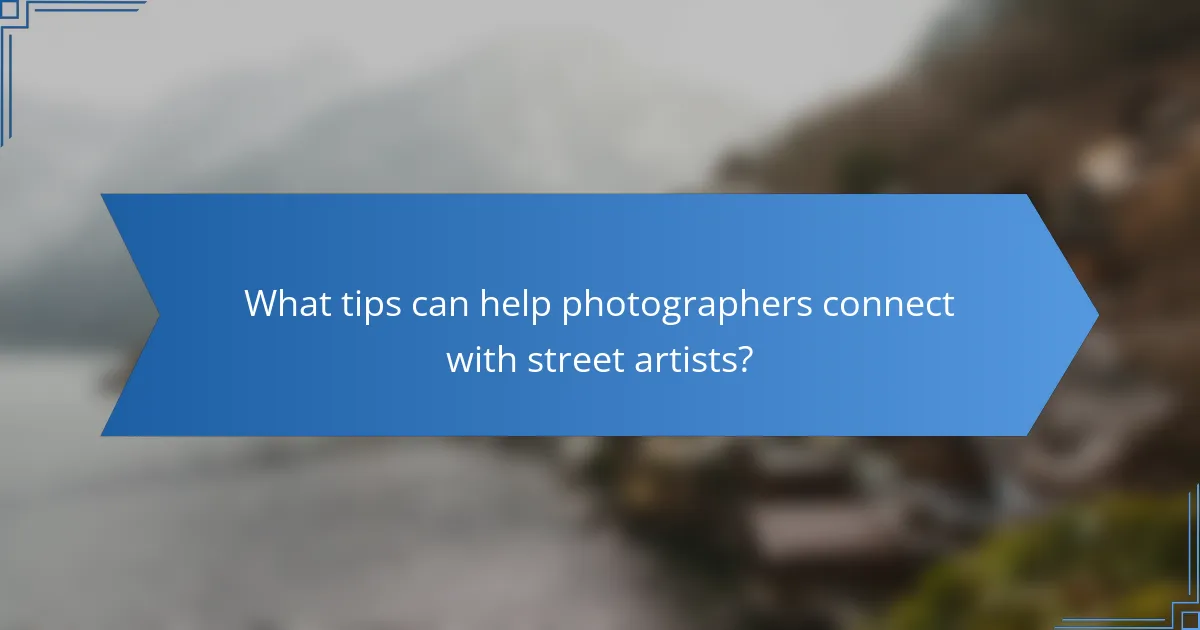
What tips can help photographers connect with street artists?
Photographers can connect with street artists by engaging in open communication and showing genuine interest. Building relationships through shared experiences enhances collaboration opportunities.
Participating in local art events fosters connections and allows photographers to meet street artists in a creative environment. Respecting the artists’ work and seeking permission before photographing their art builds trust.
Sharing the final images with the artists and crediting them on social media can strengthen relationships and promote their work. Networking within the street art community creates opportunities for future collaborations.
Understanding the cultural significance of street art can deepen the photographer’s appreciation and respect for the artists’ messages and motivations.
How can understanding the artist’s intent improve photography?
Understanding the artist’s intent enhances street art photography by providing context and depth. It allows photographers to capture the essence of urban expressions, revealing cultural narratives and societal commentary. By recognizing the motivations behind the artwork, photographers can create more meaningful images that resonate with viewers. This approach transforms a simple photograph into a storytelling medium, enriching the viewer’s experience and appreciation of the art form. Ultimately, grasping the artist’s intent fosters a deeper connection between the photographer, the art, and the audience.
What ethical considerations should photographers keep in mind?
Photographers should prioritize consent, respect cultural contexts, and avoid exploitation. Ethical street art photography involves understanding the community and the message behind the art. This ensures that the portrayal is respectful and accurate. Engaging with artists and locals fosters trust and deeper insights into the cultural significance of the work.
How can building rapport with local artists enhance the photography experience?
Building rapport with local artists significantly enhances the photography experience by fostering trust and collaboration. Establishing connections allows photographers to access unique perspectives and insights about street art, enriching their understanding of cultural significance. Engaging with artists can lead to exclusive opportunities for capturing their work and creative processes, resulting in more authentic and compelling images. Additionally, artists may share stories behind their creations, adding depth to the visual narrative. This collaboration not only elevates the quality of photographs but also promotes a sense of community and appreciation for urban art.
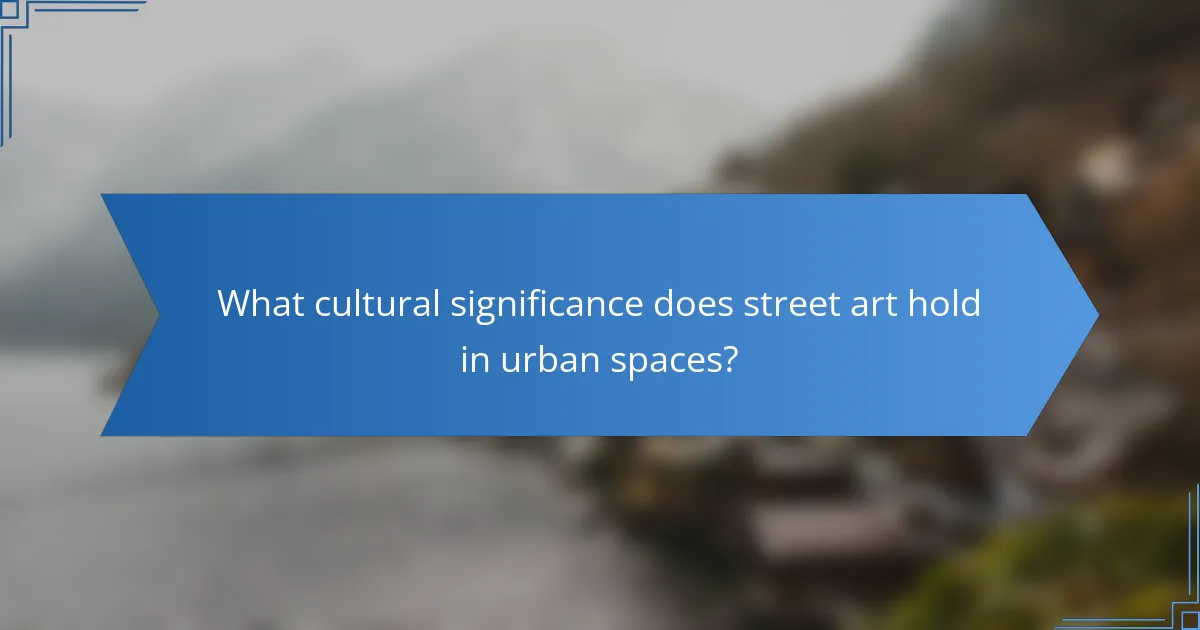
What cultural significance does street art hold in urban spaces?
Street art holds significant cultural importance in urban spaces as it reflects community identity and social issues. It serves as a medium for expression, often addressing themes like inequality, politics, and environmental concerns. Street art fosters dialogue and encourages public engagement, transforming mundane environments into vibrant canvases. This unique attribute of street art lies in its ability to democratize art, making it accessible to all, unlike traditional galleries. As a result, it plays a crucial role in shaping the cultural landscape of cities worldwide.
How does street art reflect community identity and values?
Street art reflects community identity and values by showcasing local culture, history, and social issues. It serves as a visual dialogue among residents, expressing collective sentiments and aspirations. Artists often draw inspiration from their surroundings, making each piece a unique representation of the community’s character. This art form can foster pride and unity, while also challenging societal norms and prompting conversations around important topics. In urban spaces, street art becomes a canvas for marginalized voices, highlighting diverse perspectives and experiences.
What role does street art play in social and political commentary?
Street art serves as a powerful medium for social and political commentary by reflecting community issues and challenging authority. Artists use urban spaces to express dissent, raise awareness, and provoke dialogue. This form of expression often addresses themes like inequality, environmental concerns, and human rights. For example, murals can transform neglected areas into platforms for activism, engaging the public in critical conversations. Street art’s accessibility allows diverse voices to contribute to societal narratives, making it a unique cultural phenomenon that resonates with local and global audiences.
How can street art contribute to urban revitalization?
Street art significantly contributes to urban revitalization by enhancing public spaces, fostering community engagement, and attracting tourism. Vibrant murals and installations transform neglected areas, making them more visually appealing and inviting. This artistic expression can inspire local pride and encourage collaboration among residents. As a result, revitalized neighborhoods often see increased foot traffic and economic activity. Urban areas that embrace street art typically experience a unique cultural identity, setting them apart from others.
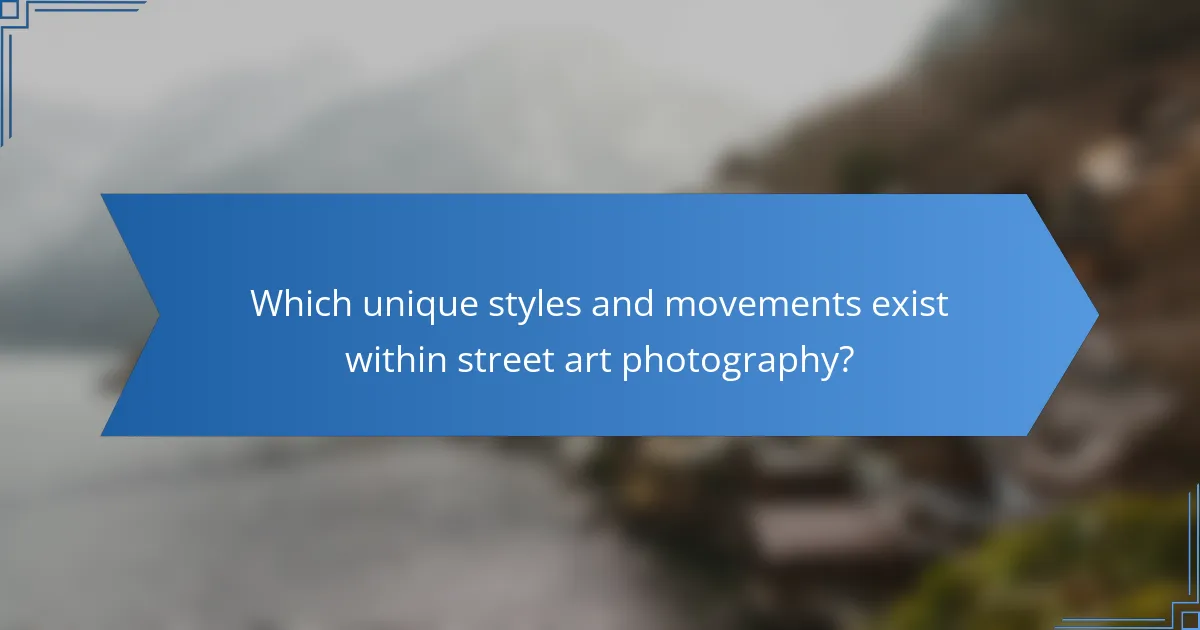
Which unique styles and movements exist within street art photography?
Street art photography features unique styles and movements that reflect urban culture. Notable styles include graffiti, stencil art, and muralism. Graffiti emphasizes vibrant colors and lettering, while stencil art offers precision and repetition. Muralism often showcases large-scale works that engage communities. Each movement contributes to the cultural significance of street art, transforming public spaces into galleries.
How do regional differences influence street art styles?
Regional differences significantly shape street art styles through cultural influences, local history, and societal issues. For instance, urban environments in Europe often feature intricate murals reflecting historical narratives, while American street art may emphasize social justice themes. Local materials and techniques also vary, influencing the aesthetic and execution of street art. Additionally, legal frameworks and community acceptance impact the prevalence and style of street art in different regions. These factors create a diverse landscape of street art that is continually evolving.
What are the emerging trends in street art photography?
Emerging trends in street art photography include the integration of technology, community engagement, and sustainability. Photographers increasingly utilize drones and smartphones to capture unique perspectives. Collaborative projects with local artists foster cultural connections and enhance storytelling. Additionally, eco-friendly materials and practices are gaining traction, reflecting a commitment to environmental awareness in urban art.
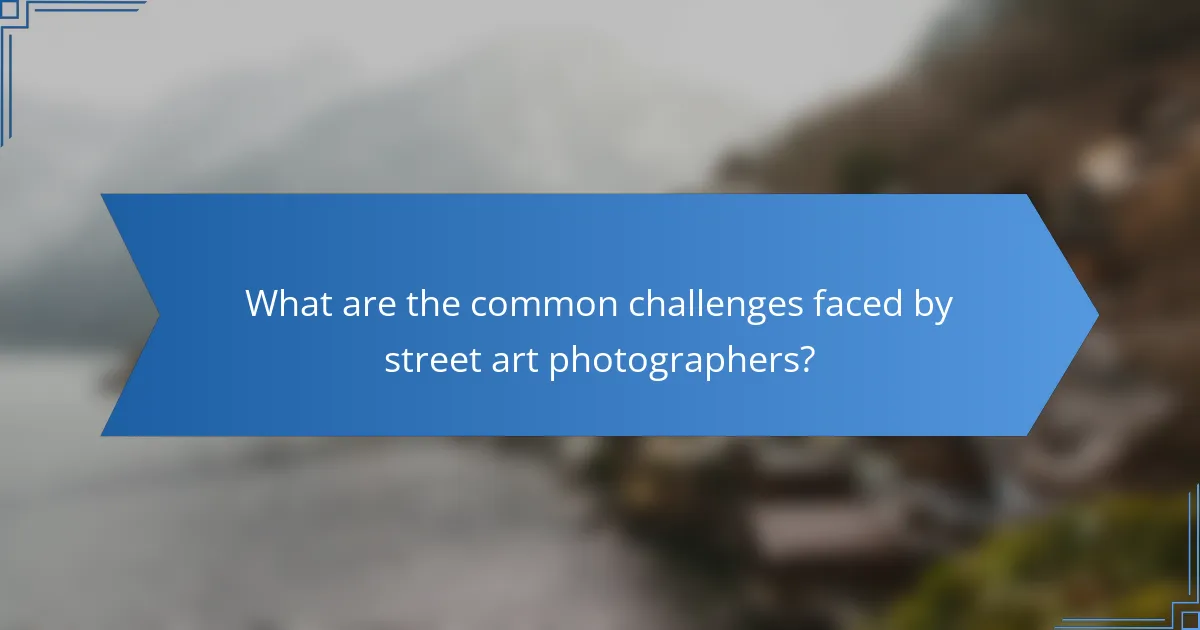
What are the common challenges faced by street art photographers?
Street art photographers commonly face challenges such as limited access to locations, unpredictable weather, and the transient nature of street art. They must also navigate legal issues regarding permissions and copyright. Additionally, capturing the essence of the art while avoiding distractions in urban settings can be difficult. Lastly, safety concerns in some neighborhoods can impact their ability to shoot freely.
How can photographers navigate legal issues related to street art?
Photographers can navigate legal issues related to street art by understanding copyright laws, obtaining permissions, and being aware of local ordinances. Street art often resides in public spaces, but the rights of the artists must be respected. Photographers should consider the context and purpose of their work, as commercial use may require explicit consent from the artist. Additionally, documenting street art can contribute to cultural preservation, which may influence legal considerations. Engaging with the artist and the community fosters positive relationships and mitigates potential legal conflicts.
What strategies can help overcome safety concerns in urban environments?
To overcome safety concerns in urban environments, engaging with the community and enhancing visibility are key strategies. Building relationships with local artists fosters a sense of ownership, which can deter vandalism and promote respect for public spaces. Utilizing well-lit areas for street art photography increases safety and encourages positive interactions. Additionally, collaborating with local authorities can lead to designated areas for street art, reducing conflicts and enhancing cultural significance. Encouraging public participation in art projects can also build community trust and improve safety perceptions.
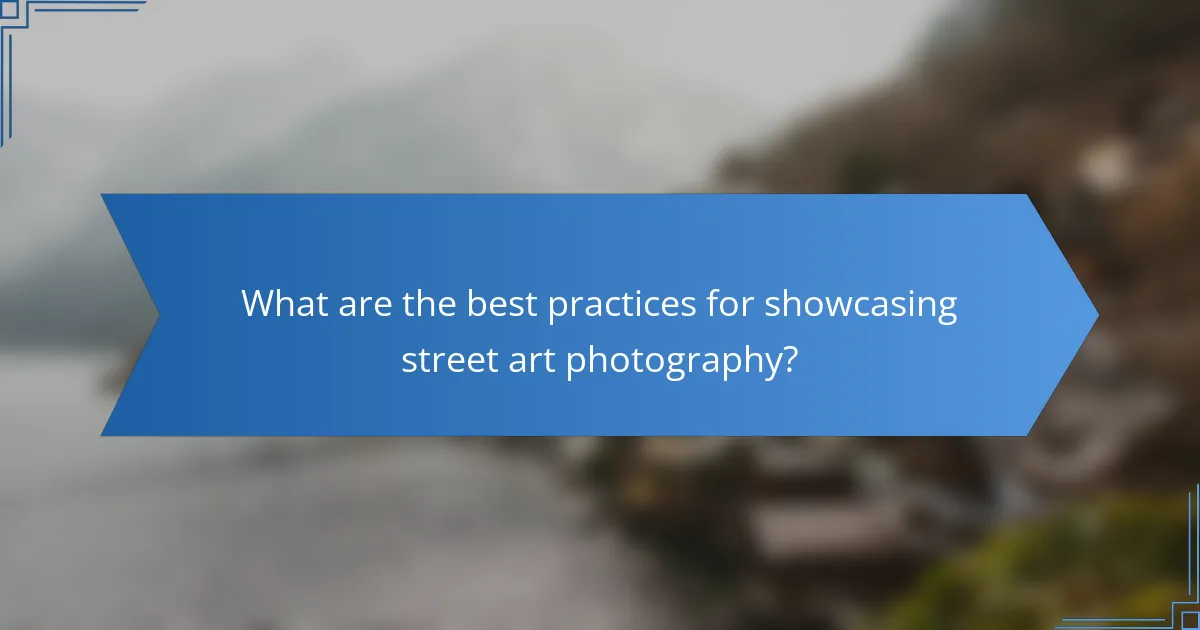
What are the best practices for showcasing street art photography?
To effectively showcase street art photography, focus on composition, lighting, and context. Use techniques like leading lines and framing to draw attention to the art. Capture the surrounding environment to provide cultural significance. Experiment with angles and perspectives to create unique images. Engage with the local community to understand the stories behind the art, enhancing your narrative. Use post-processing to enhance colors and details, but maintain authenticity.
How can social media be leveraged to promote street art photography?
Social media can effectively promote street art photography by showcasing vibrant visuals and engaging narratives. Platforms like Instagram and Pinterest allow photographers to reach a global audience, fostering appreciation for urban art. Utilizing hashtags like #StreetArt and #UrbanPhotography enhances visibility. Collaborating with local artists can create authentic content, while stories and reels provide dynamic insights into the creative process. Engaging with followers through comments and challenges builds community and encourages user-generated content.
What are effective ways to curate a street art photography portfolio?
To curate an effective street art photography portfolio, focus on showcasing diverse styles and techniques. Include high-quality images that capture the vibrancy of urban spaces, emphasizing unique attributes of each artwork. Highlight the cultural significance of street art by providing context about the artists and their messages. Organize the portfolio thematically or by location to create a compelling narrative. Regularly update the collection to reflect new trends and emerging artists in the street art scene.
How can photographers engage with audiences through exhibitions?
Photographers can engage audiences through exhibitions by showcasing street art photography that reflects urban culture. These exhibitions create immersive experiences, allowing viewers to connect emotionally with the art. By incorporating interactive elements, such as live demonstrations or artist talks, photographers can deepen audience engagement. Utilizing social media to promote the exhibition enhances visibility and invites wider participation. Additionally, collaborating with local communities fosters a sense of belonging and relevance, enriching the cultural significance of the displayed work.
What common mistakes should photographers avoid in street art photography?
Photographers should avoid common mistakes such as failing to respect the art, neglecting composition, and overlooking lighting. Respect the work by asking permission when necessary and understanding the artist’s intent. Composition is crucial; avoid cluttered backgrounds that distract from the artwork. Lastly, pay attention to lighting, as harsh shadows or poor visibility can diminish the art’s impact.